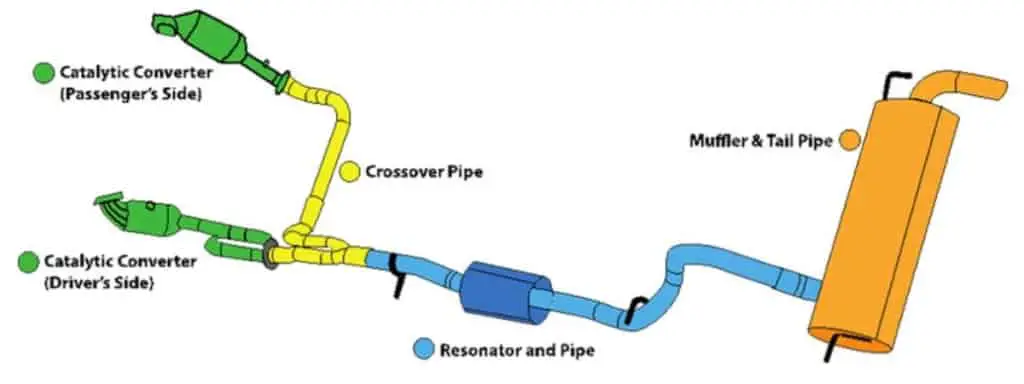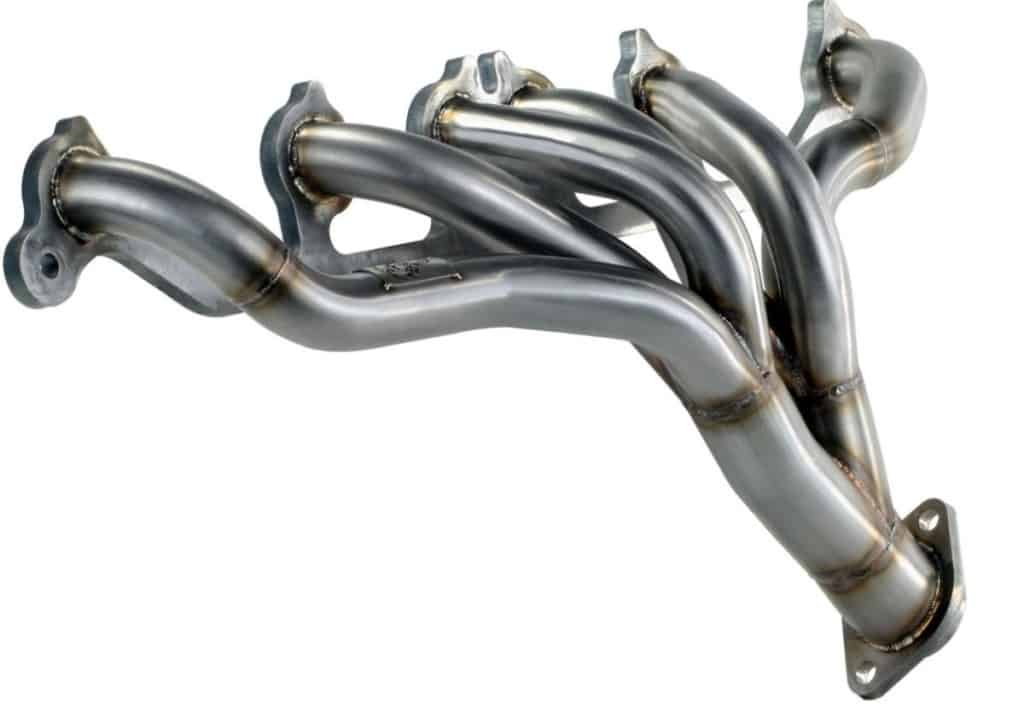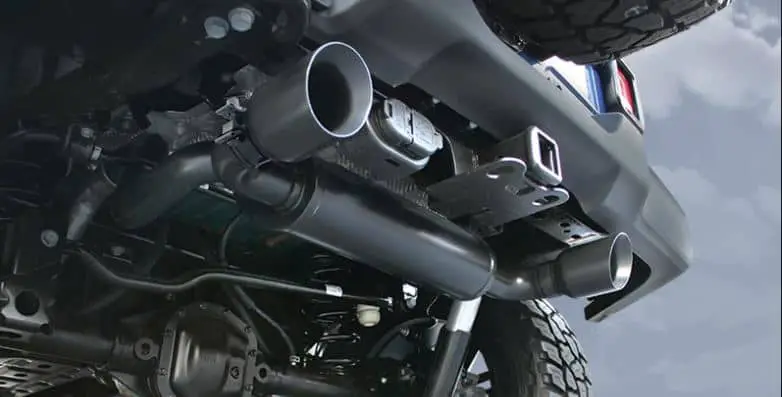Chances are, if you are on this page and researching exhaust systems, you are one of us who love the wonderful sound of a custom exhaust when your Jeep turns on or are trying to something more than what your stock exhaust offers.
However, there is also a good chance that if you are reading this article then you are not quite getting that satisfaction out of your current exhaust setup.
Well, congratulations because you came to the right place to find out what things you should be looking at when choosing a new exhaust for your vehicle (specifically your Jeep in this case).
What Are the Benefits of Aftermarket Exhaust Systems?
When it comes to bolt-on upgrades to your Jeep, it really doesn’t get much simpler than adding an exhaust system. Really the hardest part is probably getting your old mounting hardware and pipes unstuck.
But why do any of this in the first place? Let’s look at the benefits of changing out your stock exhaust for an aftermarket one.
First, it’s important to understand why a stock exhaust won’t always cut it. Vehicle manufacturers are required to meet the general needs of “everyone”.
What this comes down to is an exhaust system that meets the widest range of needs for people all over the globe in different conditions. It might be exactly what you need/want, but in general, it meets the needs of anyone with that vehicle.
So what does an aftermarket exhaust system actually accomplish? Quite a bit actually.
Usually, one of the biggest temptations to an aftermarket exhaust is an improved fuel economy. We don’t suggest that this be your primary drive as the numbers you see won’t be drastic.
However, there are some definite improvements to your efficient given you choose the right system.
Your exhaust system is designed to take hazardous gasses from your engine and “exhaust” them to the atmosphere.
So you can see where improved efficiency might take place with larger pipes or a muffler that allows a smoother flow of those gases.
This in turns adds to the overall efficiency by keeping things nice and smooth and flowing well.
The next thing an upgraded exhaust can offer is in an increase in your overall power. Understand that we aren’t talking about turning your six-cylinder into a supercharged V8.
But, by looking at some simple science, you can understand how some power increases could be accomplished. The following video gives a quick guide to the way exhaust systems work.
After seeing how exhausts are designed to work with your car, it can be pretty intuitive as to why an upgraded system would improve power. In very simple terms, power is the result of work divided by time. Where work is broken down into force times displacement.
In other words, the more displacement you have over a shorter amount of time, in theory, would result in more power.
So your answer as to how more power is accomplished is in the fact that most aftermarket exhaust systems provide a faster and larger amount of displacement to your exhaust gases.
The other, and lastly covered here, reason most people seek out aftermarket exhausts is the sound.
Manufacturers are most of the time pushed to meet certain noise restrictions and requirements when producing their product.
By adding a different muffler, you can alter the tone of your car to whatever you like by the different muffler types. You can have deep low notes or louder higher notes.
Some people even do a muffler delete (strongly not recommended) and just straight pipe the exhaust after the catalytic converter. This is an extremely loud setup and ultimately not the optimum setup you’d want to run.
What Components of Your Exhaust Are You Replacing?
As you saw in the above video, there are several components that make up the exhaust system as a whole. So, when you look into upgraded your exhaust, what components are you really looking at replacing?
Below is a diagram of a generic exhaust system. Yours might differ slightly but the principle is the same.

For your Jeep, the most common type of exhaust mods you will see on the market are either just the muffler or what’s called a “Cat-Back” system.
As the name implies, a Cat-Back is everything from the catalytic converter to the back of exhaust. These kits are more expensive but include all the pipes and muffler needed for your exchange.
In order for any kind of power increase, a muffler only upgrade usually won’t cut it. The reason being, by only changing the muffler, you aren’t changing the flow of anything before the muffler.
So, to see an increase in power or efficiency, you will want to consider a Cat-Back that gives you larger pipes and better flow directly following the catalytic converter all the way through your muffler and tailpipes.
If all you are aiming for is a change in the way things sound, you can get by with switching out your only your muffler as this is where the sound waves are broken up.
The way your muffler is designed on the inside is what affects the note/sound you will produce.
Hence why straight pipes or mufflers such as cherry bombs are so loud. They are essentially doing nothing to break the sound waves apart and thus you are getting the full exhaust note as it is leaving your engine.
If you are looking to do a complete exhaust upgrade, then you will want to dive into upgrading your headers.

While not shown in the above diagram, your headers are the connection point from your engine block to your catalytic converter.
Usually, unless you do an engine swap or some other major upgrades to how your engine performs (i.e. supercharger or turbos), you won’t need to mess with your headers.
There reaches a point, especially in Jeep engines, where you aren’t going to get enough of a difference out of stock engine to justify major header upgrades.
The truth is, your block is pushing out as much as it can. The only way to change it drastically where headers would make an impact is to supercharge/turbo it where it is seeing a drastic intake in airflow.
When Should You Upgrade Your System?
Outside of the sheer want and desire to accomplish the above-mentioned results from an exhaust upgrade, what signs or symptoms point to needing to upgrade?
The occasional visual inspection of your entire exhaust system can be quite fruitful. As your vehicle gets older, visual signs of failure can begin to appear.
Things like rust, cracks, or failing connections can all be signs its time to look at an upgrade.
In the case of your headers, cracks can often form at the joints where all headers meet into a single outlet. Often times, due to the extreme temperatures at the heads, a splash of cold water or rain downpour can cause non-quality headers to crack or split.
In this case, not only will you notice a loss of power and increase in noise, but you are also not exhausting your gases to a safe location and need to look at replacing and upgrading your headers.
In any part of your exhaust system, when considering an upgrade, look for parts that come in stainless steel.
Other signs that should be indications of maintenance/repair include significant loss of power, difficulty with hills or acceleration, rough/loud idle, and poor fuel economy.
On older vehicles, the fine metal “honeycomb” inside your catalytic convert can break and become brittle. This leads to improper emissions and poor airflow through the rest of the exhaust.
Even if you decide to go with a Cat-Back system, take the time to inspect and evaluate your catalytic converter and consider replacing it. Due to the fine metals inside, converters can be quite expensive.
Because of the simplicity of this upgrade, it should be one you consider fairly soon into owning your Jeep.
By upgrading to a quality exhaust, you can help extend your engine life by reducing things like backpressure and restrictive airflow. Both things can add unnecessary stress to your engine.
If you know your end goal with your Jeep is a lot of off-roading adventures, choosing to upgrade to an aftermarket exhaust can aid in your performance off-road.
While numbers vary from Jeep to Jeep, there is evidence to prove that better functioning exhausts can allow for better low-end torque. This is the Jeeper’s dream as torque is what allows for a slow and steady trek across the terrain.
Lastly, an aftermarket exhaust system should be considered when looking for extra clearance underneath your Jeep.
Different designs can help eliminate low hanging exhaust parts by rerouting them to high locations. This, in turn, can help to avoid damage to components or high centering in your Jeep.
The rerouting of bulky exhaust parts can also free up much-coveted space and allow for other modifications to be installed or stored on the underside of your vehicle.
Whatever your reasons for considering an exhaust upgrade, we believe there are really no “cons” to the modification outside of cost and time.
Aftermarket exhausts perform equal to and mostly better than stock exhausts systems and pose no threat to your vehicle’s well being.
Things to Look for When Exhaust Shopping
First off, as we mentioned before, step number one in modifying your exhaust system determines what parts of your exhaust you are wanting to change.
When shopping, these components will usually be referred to as:
- Axle-Back Systems
- Mufflers
- Cat-Back Systems (DPF Back on Diesels engines)
- Headers/Manifolds
If you have the resources, time, and motivation, opting to replace as much of the factory system as possible (excluding headers) will provide the most benefit in increased airflow.
After determining exactly what it is you plan on buying, your next step is to evaluate what materials you want your parts to be made of.
Our personal recommendation is to opt for stainless steel parts when able to. Keeping in mind, do your research on which stainless steel grade is right for you. Some stainless steels are more resistant to corrosion than others.
However, if you live in a dry and arid region, you would be fine to simply adhere to aluminum components.
After finding what materials you think suitable for your situation, head to the forums we always recommend. Search for exhaust threads and see what people are referring to and what people are steering clear of.
After narrowing your choices down to two or three, weigh the pros and cons as relevant to your particular setup. Not anyone muffler is best for all Jeep setups.
Pro Tip: as much as you might think you want the loudest and baddest sounding exhaust out there, give careful thought to what is actually best. Nothing can ruin a good day on the trails than someone with an obnoxiously loud exhaust that overpowers the surrounding environment.
It also doesn’t take long to get tired of cranking your radio louder and louder to hear over your hum down the road. There are many muffler options that allow for a mean sounding low growl but won’t drone you out when cruising down the road.
Choosing the Right Muffler for Your System
Even if you choose to update more than just your muffler by either doing a Cat-Back or entire exhaust system, you still have the choice of what muffler to include in your setup.
One simple thing to understand in choosing mufflers is to know that the more a muffler is designed to be “race ready”, the louder it will be.
The reason for this is the fact that a more race-ready muffler is going to have fewer restrictions to allow for maximum airflow. With fewer baffles in the muffler, you will be closer to a straight pipe set up which have discussed as being extremely loud.
Because your Jeep isn’t probably on the market to be an extreme racer, you will be better off leaning towards a muffler that simply compliments your engine’s natural tone.
As a rule of thumb, the smaller the muffler the louder it will be. As you can deduce from the rest of our discussion, this because a smaller muffler will restrict the airflow more and cause less dissipation of the sound waves.
Some of the top brands in exhaust setups and mufflers are listed below:
You’ll find that any of these brands have their loyal group of followers and those who might adamantly oppose one over the other.
For you, JK owners out there, check out this video from Extreme Terrain where they lay out their top choices for Cat-Back systems and why.
While this video is specifically for 4 door JKs, the information and brand suggestions remain the same.
To truly decide on what you find best you would have to test them all. At some point, you just have to go with one and form your own opinions on its value.
In any case, you’ll want to ensure the muffler you choose is quality. One way to do that is to make sure your muffler has welded components. Meaning the baffles inside your muffler are all-welded to the shell and the shell has a solid weld bead on all edges.
Conclusion
How you design your Jeep exhaust helps to define the personality of your Jeep. Dependent on what engine you have (especially if you’ve done diesel or V8 Swaps) you’ll find that you might have different needs than someone running a stock engine.
An exhaust by itself can complement and aid in your Jeep’s performance. But remember that it acts in compliment with other things.
An engine can only output as much air as it is receiving. So to better complement a high-performance exhaust, you need to alter how your engine is receiving air and in what quantities.
You might find cold air intakes will help. But in most cases, to really boost an engine’s performance you have to consider more drastic things like superchargers or turbos or tune kits.
As always, your path in the wilderness is your own. How you decide to get there is the journey in and of itself. Just remember to keep the wilderness on YOUR side and Siberian 4×4 is here to help you do just that.

